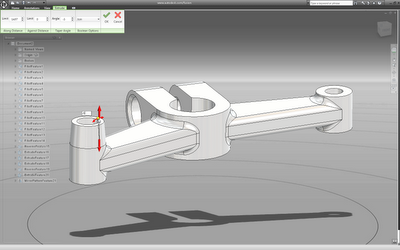Autodesk has officially launched Inventor Fusion (we reported on it at AU late last year). The company has finally come out from the cloud of secrecy surrounding Inventor Fusion and talked to the press/media about it openly. While there’s not been a great deal new learned in the last few days (as it’s still a while away from becoming available) it’s worth answering the major questions that cropped up. We’ve also got some better quality video showing how the system works in different use cases, so let’s mix up the two.
#1: Why?
This one is easy. Inventor is currently a history-based parametric modeling system. Quite a number of Autodesk’s competitors have been developing systems which are not. These systems allow you to dynamically edit geometry without recourse to parametric design, without recourse to history – no regeneration, not flipping hourglass. Due to the nature of these systems, they allow you to work with geometry from other systems nicely.
And those other vendors have been making quite a lot of noise about it. Hence, Autodesk’s response. Yes, I’m sure everyone’s been working on something similar. Facts of the matter are that workstations of the last 20 years (since the release of Pro/E) have not had enough power to carry out these types of calculation in one go.
As a result, each model’s construction was split up into chunks (features) and executed in linear order (history). But we’re now at a stage where the compute power in your average workstation is sufficient enough to allow to do both, simultaneously. While the development of this technology was inevitable, the release of SpaceClaim and the subsequent acquisition of CoCreate by PTC, all brought things to a head and provided the catalyst. Here we are.
#2: Is it the new Inventor?
No. Not yet. It’s a technology preview. As such, its a system that you’ll be able to download and play with. Essentially, Autodesk want users to knock the rough bits off it, kick it into shape and see where it goes.
#3: Will it be the new Inventor?
No. Well. Sort of. The name is the clue. Fusion is about bringing in a new technology into the Autodesk offering. Eventually, I would imagine and it was confirmed during the launch web-conference, that all of this technology (in whatever form it ends up once the Technology Preview is over) will become part of standard Inventor – unless users want otherwise.
#4: What’s the difference between this and SpaceClaim, CoCreate, and Siemens‘ Synchronous Technology et al?
The modeling technology is not particularly unique. Whatever system you work with, if you’re working with basic, prismatic and well translated parts, then it’ll work like a dream. Step outside of that, and it won’t. Basic topology changes will be OK, dramatic ones will not.
Inventor Fusion does have some very nice User Interface details, radial menus at cursor (rather than menu), stripped back dialogs, context sensitivity – it’s all there. It’s very NX like in fact. For me, that’s a 100% good thing.
#5: So, it looks like other systems, works like them, what’s the Big Deal?
The Big Deal is this. Now, this is only demo-ware at the moment, but the potential is huge. You can take a history+parametric+feature-based part from standard inventor into Inventor Fusion. In Fusion, you can edit the geometry of the part, delete faces, move specific instances from a pattern.
You can then read it back into Inventor, have the system interrogate the part and reconfigure the history and feature tree to accommodate those changes. Whizz bang, your part has been round-tripped successfully, edits made without recourse to history.
Now, the quick amongst you (or the cynics) will say – surely that shows that you’re lacking tools in standard Inventor. Absolutely. but consider that eventually, this technology will be one and the same system. that’s intriguing. That’s mix and matching direct editing with parametric and history-based design and maintaining that history. Creating a Fusion. That, my friends, is very interesting indeed. See, I told you it’s all in a name.
Register your interest at www.inventorfusion.com








